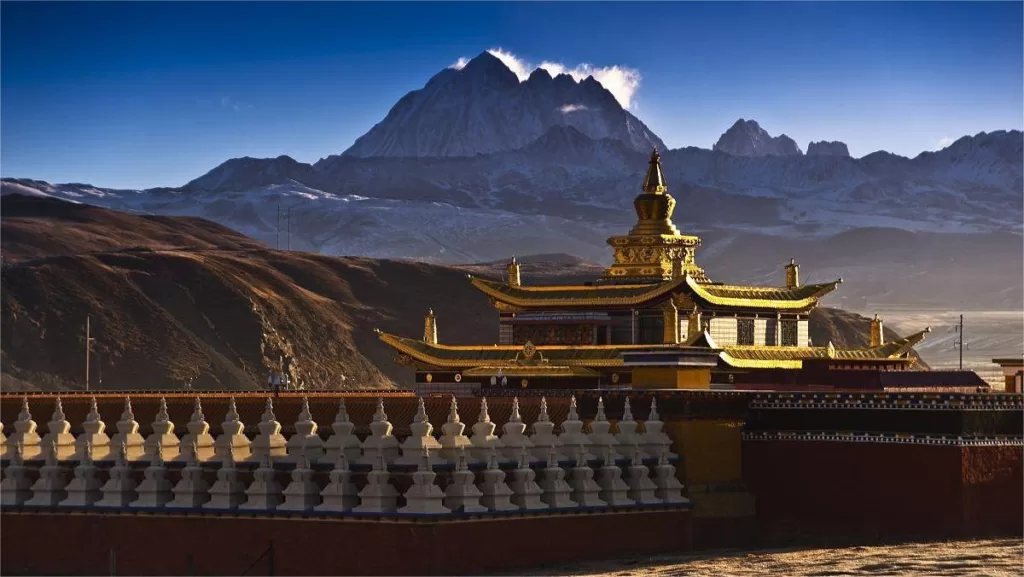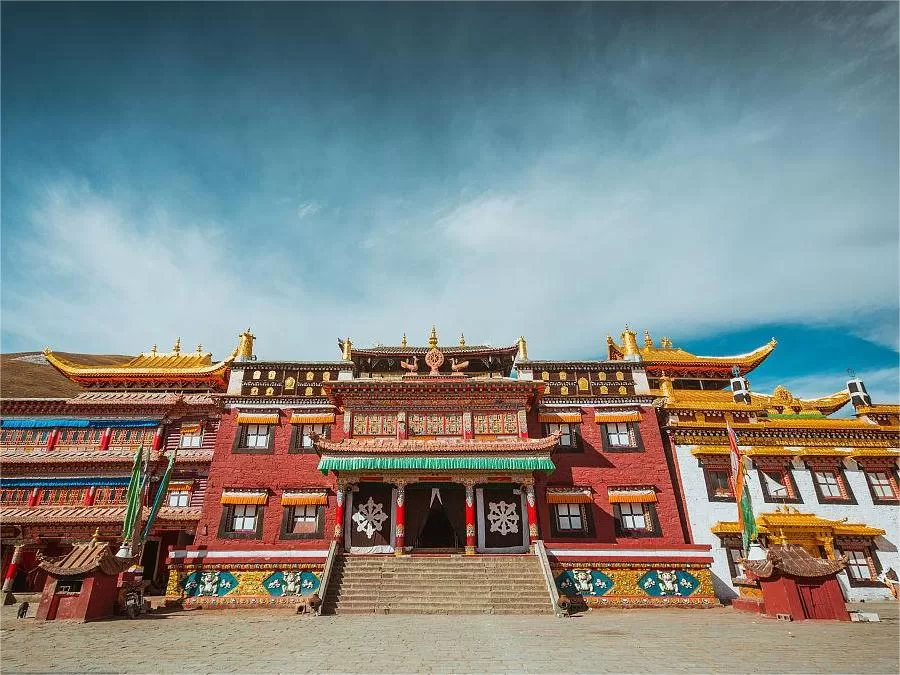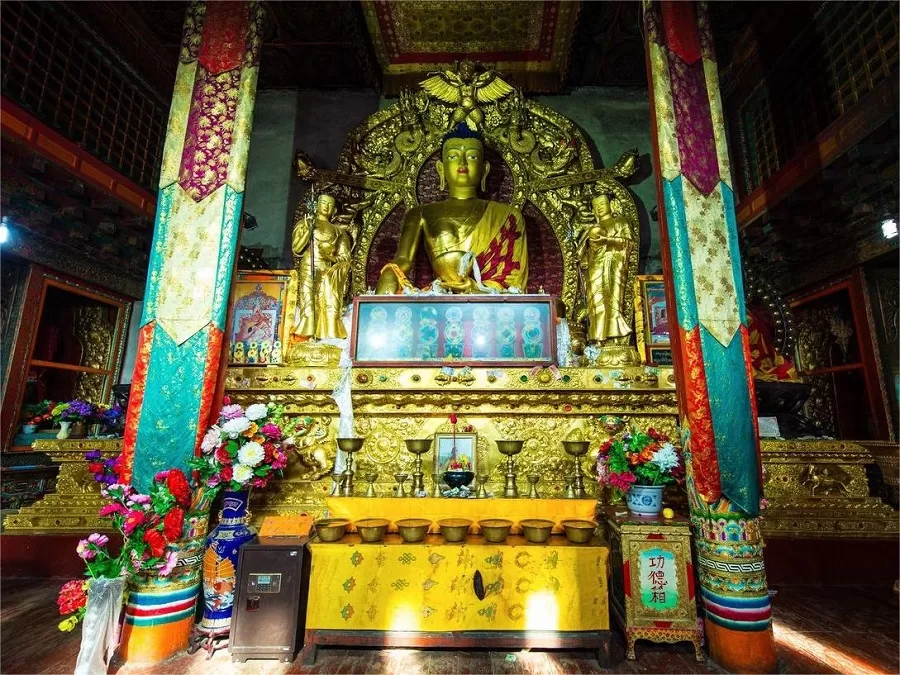Tagong Monastery – Ticket Price, Opening Hours, Location, and Highlights


Tagong Monastery (塔公寺), also known as “Small Jokhang Temple,” is a renowned Sakya sect (also known as the Flower School) monastery in Garze Tibetan Autonomous Prefecture, Sichuan Province, China. With a history spanning over a thousand years, it stands alongside other prominent monasteries like Yarchen Monastery and Larung Gar (Seda Buddhist Institute). In the Tibetan language, “Tagong” means “a place beloved by Bodhisattvas,” and the monastery is revered as one of the sacred pilgrimage sites for the Tibetan people in the Kham region.
Situated 110 kilometers from Kangding County, Tagong is reached by heading west along the Sichuan-Tibet Highway from Kangding, crossing the stunning Zheduo Mountain, and continuing north after reaching Xinduqiao until arriving at Tagong Monastery. The backdrop of Tagong is the majestic Yala Holy Mountain, rising dramatically from the grasslands, adorned with perpetual snow, surrounded by swirling clouds. This picturesque scene, coupled with the vast green meadows and the resplendent Tagong Monastery, creates a captivating panorama of the Tibetan plateau.
During the summer and autumn seasons, the grasslands around Tagong Monastery are adorned with colorful flowers, and meandering streams add to the scenic beauty. The landscape is dotted with herds of cattle, sheep, and horses, as well as nomadic tents and the temple towers of Tagong Monastery, presenting a vibrant and enchanting spectacle.
Table of Contents
- Basic Information
- Location and Transportation
- Highlights of Tagong Monastery
- Video about Tagong Monastery
- Useful Tips from Genuine Reviews
Basic Information
| Estimated Length of Tour | 1 hour |
| Ticket Price | 20 RMB |
| Opening Hours | 8.00 – 18.00 |
Location and Transportation
Tagong Monastery is located in the small town of Tagong, which lies in the western part of Sichuan province, China. The town is situated within the picturesque Garze Tibetan Autonomous Prefecture, also known as Garzê Tibetan Autonomous Prefecture.
Tagong Monastery itself is perched on a hill on the Tagong Grassland overlooking the town, making it an integral part of the landscape. The proximity to the magnificent mountains and the peaceful surroundings adds to the spiritual aura of the monastery, making it a popular destination for both pilgrims and tourists seeking solace and cultural immersion.
Access to Tagong is primarily by road, and while it might be a bit remote, the journey to this sacred site is undoubtedly rewarding for those seeking a genuine and enriching experience of Tibetan culture and Buddhism.
Highlights of Tagong Monastery
Lengend about Tagong Monastery

Legend has it that in the year 641 AD, Princess Wencheng was en route to Tibet. When she reached the location of Tagong Monastery, the Buddha statue she carried, known as the “Sleeping Buddha,” inexplicably took root in the ground and could no longer be moved. As the perplexed crowd pondered the situation, the Buddha statue miraculously spoke, expressing its willingness to stay in this sacred place. Princess Wencheng promptly decided to have a replica of the Buddha made on the spot using locally sourced golden sand, leaving it in Tagong.
Only after the new statue was completed did the original Buddha become mobile again, continuing its journey to Lhasa, where it was eventually enshrined in the Jokhang Temple. Due to the extraordinary and mysterious connection between the two statues, a belief arose that those who were unable to fulfill their pilgrimage to Lhasa could attain similar blessings and merits by paying homage to the Shakyamuni Buddha statue in Tagong Monastery. This led to Tagong Monastery being affectionately referred to as the “Small Jokhang Temple,” highlighting its special significance and spiritual power akin to the renowned Jokhang Temple in Lhasa.
Buddhist Affairs

Tagong Monastery hosts annual Buddhist ceremonies, including:
- Lunar New Year Prayer Festival (1st to 15th day of the first lunar month): A grand ceremony to pray for world peace, the prosperity of Buddhism, the elimination of obstacles, and auspicious weather throughout the new year.
- Great Sun Buddha Festival (1st to 10th day of the fourth lunar month): Devotees engage in the practice of the Great Sun Buddha, conduct fire offerings, and perform rites to transfer merits to departed souls.
- Protector Deities Festival (1st to 14th day of the sixth lunar month and 24th to 29th day of the twelfth lunar month): During these events, practitioners make offerings to protector deities, perform the energetic Vajra dance, and seek blessings for protection. These ceremonies are integral to the spiritual life of Tagong Monastery, fostering a sense of community and devotion among the practitioners.
Shijia Hall and Its Treasures

Shijia Hall in Tagong Monastery houses the revered statue of Shakyamuni Buddha, sculpted by Princess Wencheng. The hall also preserves the miraculous footprint left by the Yuan Dynasty’s Eighth Karmapa on a stone, showcasing his divine abilities. Additionally, a one-meter-high statue of Avalokiteshvara, crafted by Princess Wencheng for the benefit of all beings, graces the hall. This sacred statue was fashioned using materials from the divine mountains and waters of the Han-Tibetan region, along with abundant jewels. Legend holds that the Avalokiteshvara statue possesses extraordinary mystical powers, adding to the spiritual richness of Shijia Hall within Tagong Monastery.
Other Buddist Heritage

Tagong Monastery boasts several other Buddhist treasures within its premises:
- Guanyin Hall: This hall enshrines a gilded bronze statue of the Thousand-Armed, Thousand-Eyed Guanyin, the tallest in all of Tibet, completed in 1997.
- Achievement Stupa: Constructed with esoteric methods by the accomplished practitioner Hongqin Garen, it holds the staff and relics of the Indian sage “Hongqin Garen.”
- Relics Collection: The monastery safeguards relics such as the tooth of “Sangye Tuppa” (Buddha Kashyapa), the ritual bell used by the 12th-century Indian master “Naro Khenchen,” and a gilded bronze Buddha gifted by the Yuan Dynasty’s eminent master, the Eighth Karmapa.
- Buddhist Artifacts: Tagong Monastery also preserves numerous precious Buddhist artifacts and Sakya sect scriptures, making it a repository of rare and invaluable treasures for visitors and devotees.
Pilgrim’s Path

The pilgrim’s path to Tagong Monastery is a sacred journey cherished by Tibetan Buddhists seeking spiritual solace and blessings. With devout hearts and prayer beads in hand, pilgrims trek across the picturesque landscapes of the eastern Tibetan plateau, drawn to the ancient sanctuary’s spiritual aura. Along the way, they traverse through vast grasslands and serene mountain passes, embracing the rugged beauty of the terrain as an expression of their devotion. The pilgrim’s path is not merely a physical journey but a profound inner exploration, symbolizing the quest for enlightenment and the deep connection between humanity and the divine.
Video about Tagong Monastery
Useful Tips from Genuine Reviews
Opening Times and Events:
- Tagong Monastery may occasionally close, so it’s advisable to check in advance if it’s open before planning your visit. This can prevent disappointment due to unexpected closures.
- If possible, plan your visit around June 30th when the monastery holds Buddhist events lasting for three days. This could offer a unique and culturally rich experience.
Prayer Wheel Etiquette:
- Outside the monastery, there are prayer wheels that visitors can freely explore and turn. Note that the proper way to turn the prayer wheel is in a clockwise direction, following the traditional Tibetan Buddhist practice.
Respectful Behavior:
- Abide by the rules and regulations of the monastery. Respect Tibetan culture and the beliefs of the local people. This includes taking off your shoes when entering the temple and refraining from taking photographs, especially in sensitive areas.
- Visitors should be mindful of their behavior and dress modestly when visiting religious sites.
Visiting Hours and Restricted Areas:
- Explore the main Buddha hall within the monastery, but be aware that the monks’ residential areas are off-limits to visitors. Respect the privacy and sacredness of these spaces.
Photography Timing:
- Optimal times for photography are early in the morning and during the late afternoon when the light is softer. This is considered the best time to capture the beauty of Tagong Monastery and the surrounding snow-capped mountains.
Attractions in Garze, Sichuan scenery, Sichuan Tibetan Area